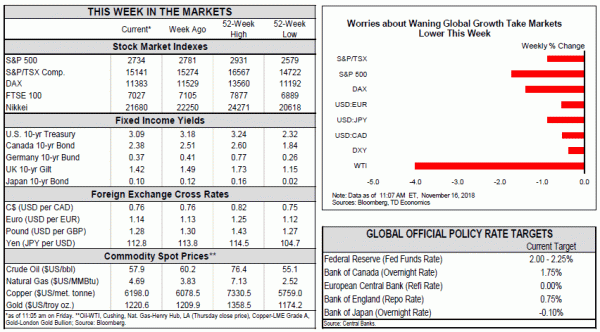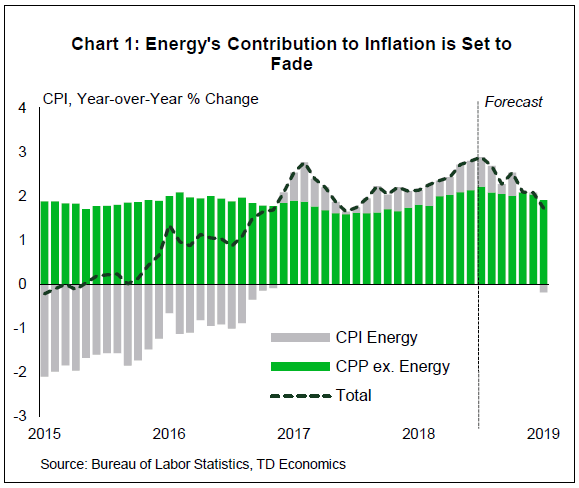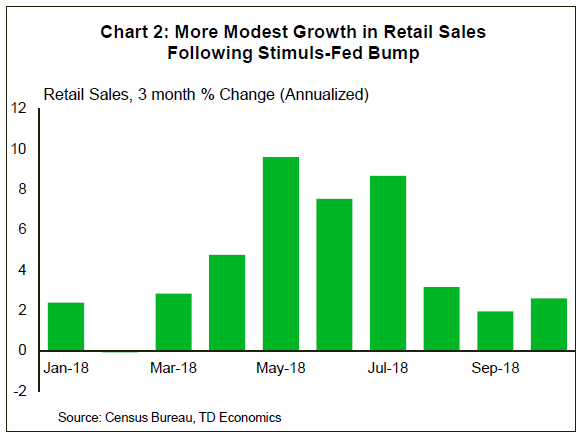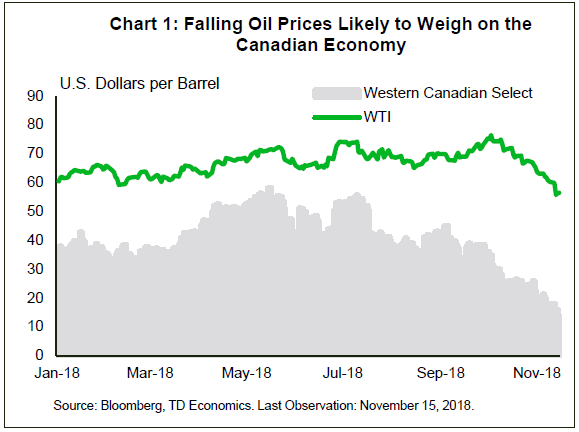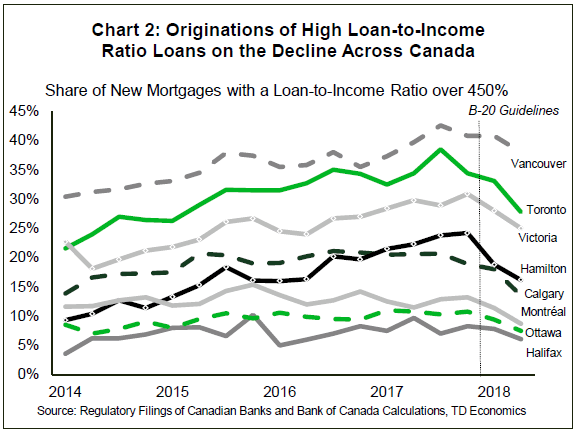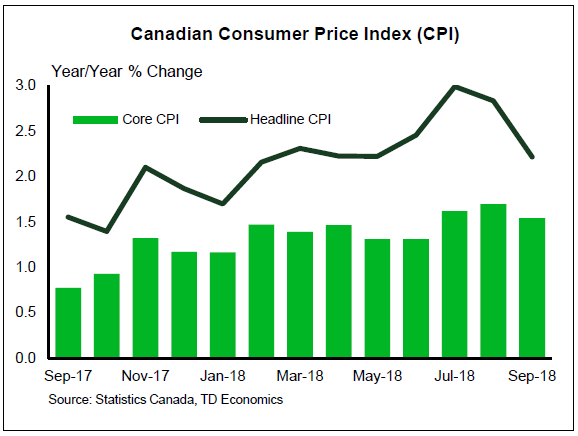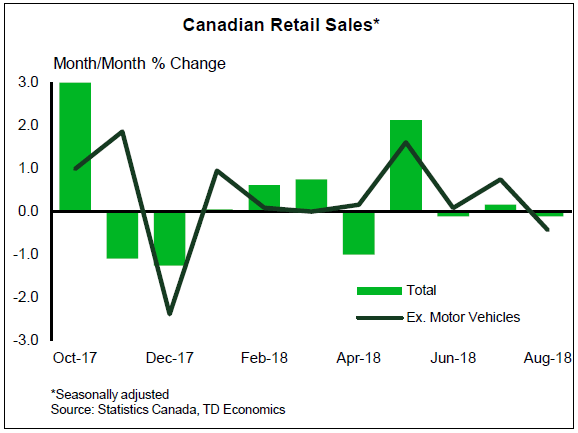U.S. Highlights
- Equity markets were volatile again this week as concerns over global growth remained top of mind for investors.
- Economic data continues to point to solid economic growth stateside, with little signs that global weakness has caught on domestically.
- Inflation data for October showed a relatively benign picture. While the headline rate rose to 2.5% (from 2.2%), core inflation edged lower on the month.
Canadian Highlights
- Concerns over slowing demand and rising supply drove oil down to the mid-U.S. $50 range this week. Together with the persisting large discount on heavy crude, the lower price of oil is likely to have some negative consequences for the Canadian economy.
- On the housing front, existing home sales declined for the second consecutive month in October, suggesting that the recovery from the B-20 slump in the first half has run its course.
- Encouragingly, Bank of Canada research released this week revealed that regulatory changes in the mortgage market have improved lending quality, and may be helping to reduce financial stability risks.
U.S. – Growth is Solid, Inflation is Benign, Why Worry?
It was another volatile week in financial markets as fears around slowing global growth were exacerbated by worries over Brexit. This, as the cabinet minister in charge of negotiating a Brexit deal with the European Union resigned over the direction of the proposed deal. The S&P 500 finished the week down 2.1% as of writing.
Financial market jitters are not a reflection of any newfound weakness in U.S. economic data, which continues to point to solid growth and limited inflation. This week, consumer price index (CPI) data for October showed headline inflation rise to 2.5%, mainly due to rising energy prices. Core inflation, on the other hand, edged down to 2.1% (from 2.2%). Over the past three months, core prices have risen an average of just 1.6% (annualized), suggesting little cause for alarm on the price front. What’s more, the recent pullback in the price of oil is likely to push headline inflation lower in the months ahead, with the Fed’s preferred metric – the personal consumption expenditure price index – likely to drift back below the 2% mark.
A relatively soft inflation environment is giving support to the more dovish voices on the FOMC. In comments made this week, Chair Powell struck a balanced tone, but gave a nod to some of these more dovish elements. In particular, he noted the conditions that could lead the Federal Reserve to slow its pace of rate hikes over the next year. Slowing global economic growth, fading fiscal stimulus, and the lagged impact of past rate hikes are three factors that the Fed is monitoring. Despite these risks, the Chairman also noted the relative strength in the American economy, and notably that with press conferences scheduled after every Fed announcement in 2019 (instead of just once a quarter), every meeting is “live” – that is, has the potential for a change in policy.
Other economic data confirmed the solid economic growth narrative. Retail sales rose a robust 0.8% in October, reversing a downwardly revised pullback in sales in September. The drop in September and rebound in October reflected hurricane-related disruptions. Overall, the retail sales data are consistent with real consumer spending advancing by around 2.5% in the fourth quarter. For all intents and purposes, this is a great number. Nonetheless, it does represent a deceleration from the heady 3.9% pace average over the second and third quarters of the year.
With real consumer spending likely to run in the mid-2% range, the overall economy is likely to follow suit. In this environment, the impact of tariffs is likely to be more noticeable. Already there are signs that businesses are attempting to get ahead of the scheduled increase in Chinese tariffs to 25% (from 10%) by stockpiling imports. This volatility makes reading the economic tea leaves and the job of the Fed in gauging the reaction of the economy to higher interest rates that much more difficult.
Canada – Oil Industry Woes to Weigh on Growth
Concerns about slowing global growth and political developments this week dominated headlines, overshadowing domestic developments. Evidence that global demand is slowing continues to build, helping to take the bid out of commodity markets. WTI oil plunged to U.S. $55 this week on oversupply concerns before bouncing back above $56 per barrel. The 14% decline in oil prices since the end of October is an unambiguously negative development for the Canadian economy, particularly as temporary disruptions and supply bottlenecks persist keeping the price discount for heavy crude at over U.S. $40 a barrel (Chart 1). The slump in oil prices is also weighing on the loonie, keeping it a couple ticks below U.S. 76 cents – down 2.8% from its post USMCA high at the start of October.
The slump in the price of oil is hurting Canada’s terms of trade, and the move in the loonie is a reflection of the resulting loss in purchasing power. If the decline in oil prices and the discount on heavy crude were to persist, it may have a more lasting negative effect on gross domestic income. On that front, rumour of an upcoming production cut by OPEC+ that is likely to be announced at its December 6th meeting will likely put a floor on prices in the near term. However, the large discount on heavy crude could last for a few more months since additional rail capacity will take some time to come online.
Slower income growth is the last thing that the Canadian economy and its highly indebted households need. Above-trend growth, low unemployment, and inflation at target are all factors that have given the Bank of Canada enough confidence to remove stimulus, resulting in the 125bp increase in its policy interest rate since July of last year. Together with the global rise in interest rates, this has helped to drive mortgage rates higher. Indeed, higher rates and regulatory changes have weighed on housing this year. Existing home sales in October declined for the second consecutive month, suggesting that the summer bounce from the B-20 drag in the first half of the year may be done. Although price growth remains subdued, affordability remains strained in key markets. More new supply could help improve housing and rental affordability. On that note, in its fall economic statement, the Ontario government announced a plan to help encourage rental supply by removing rent control from newly built units.
Waning global demand and lower oil prices are the latest concerns that complicate matters for the Bank of Canada as it contemplates further rate hikes. However, the high level of household debt, and the associated increased sensitivity of the Canadian economy to higher interest rates, remains the top concern. Encouragingly, Bank research found that the regulatory changes in the mortgage market have improved lending quality (Chart 2) nationwide. This should provide some comfort that actions taken by regulators are reining in financial stability risks.
Canada: Upcoming Key Economic Releases
Canadian Consumer Price Index – October
Release Date: November 23, 2018
Previous: -0.4% m/m, 2.2% y/y, Index: 133.7
TD Forecast: 0.2% m/m nsa, 2.4% y/y, Index: 134.0
Consensus: N/A
We expect CPI to inch higher to 2.4% in October on y/y tailwinds from energy and food prices. Airfares have fully unwound their previous jump and therefore pose less risk to the figure this month, though the methodology changes still make the figure uncertain. Most of the attention will be on the core measures this month, as the report marks the last inflation print ahead of the December BoC meeting. Average BoC core ticked back to 2.0% and there is risk for a rebound back to 2.1%, raising odds of multiple rate hikes in the next three meetings. However, headline inflation is still the Bank’s main target, and the latest oil rout leaves inflation tracking below the BoC’s projections at 2.0% in Q4 vs 2.3%.
Canadian Retail Sales – September
Release Date: November 23, 2018
Previous Result: 57.8
TD Forecast: 56.9
Consensus: 56.2
Retail sales are expected to come in unchanged for September as a pullback in motor vehicle sales offsets a modest increase in the core. Motor vehicles are poised for their third decline in the last four months as consumers grapple with higher debt costs and prioritize spending elsewhere. However, we expect ex-auto sales to rebound by 0.3% m/m on a recovery in import activity as well as strong employment data. Electronics should benefit from the release of new iPhone models mid-month although lower prices at the pump will weigh on gasoline station sales.
Real retail sales should come in at or slightly above the nominal print owing to a modest decline in seasonally adjusted consumer prices for September. This would cap off a relatively disappointing quarter for retail activity in Canada, with sales up a muted 0.5% (annualized) for Q3 as a whole, consistent with a moderation in household consumption from Q2.




